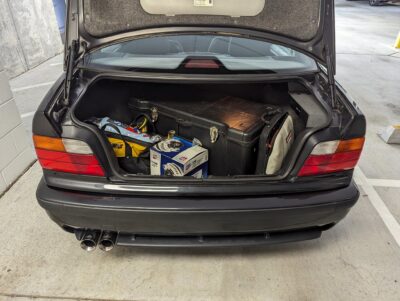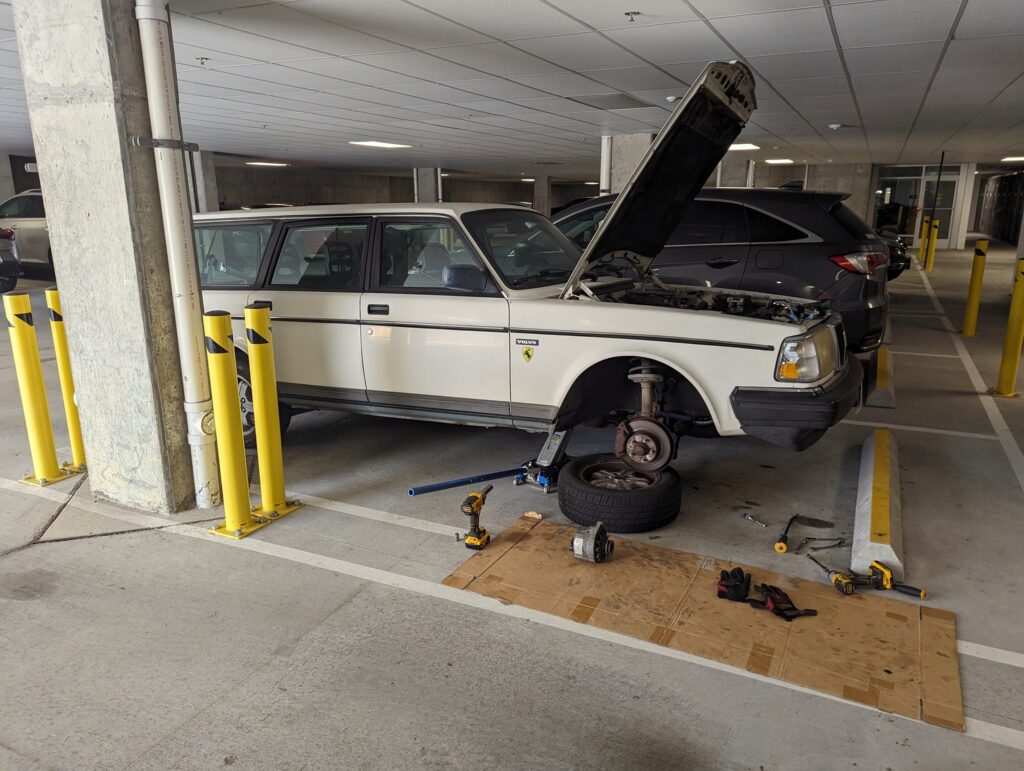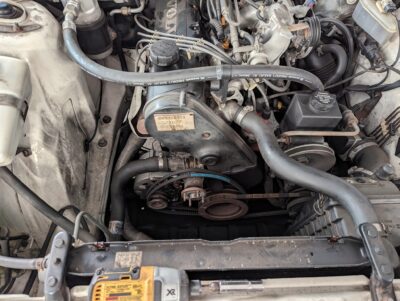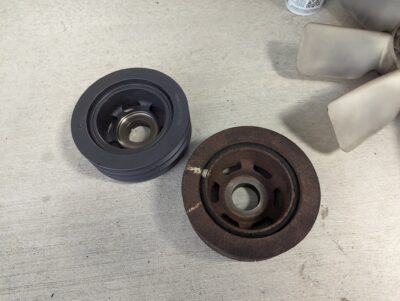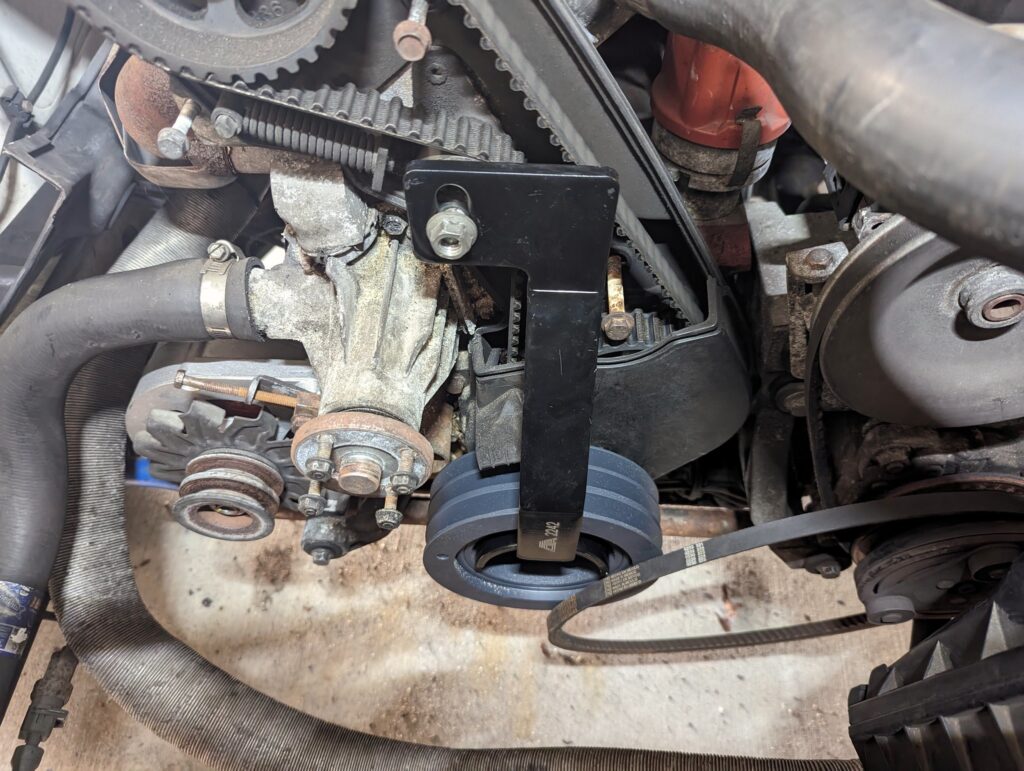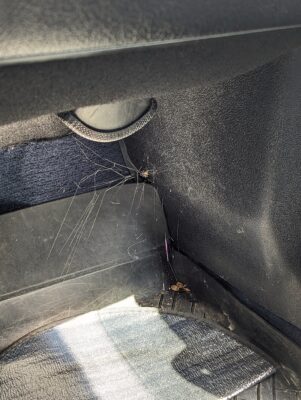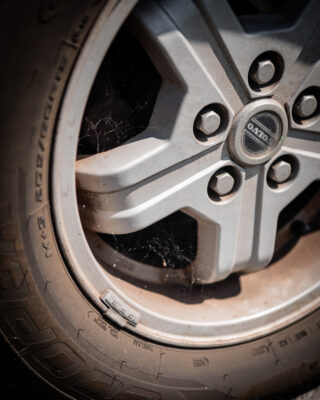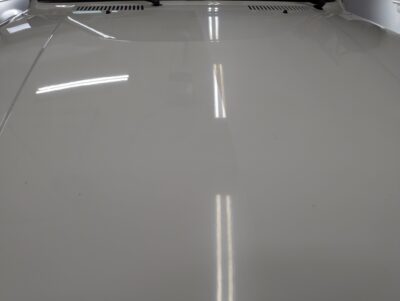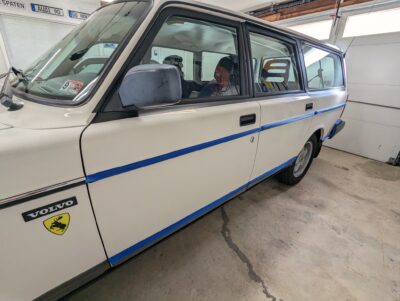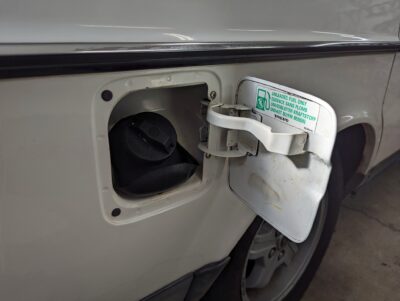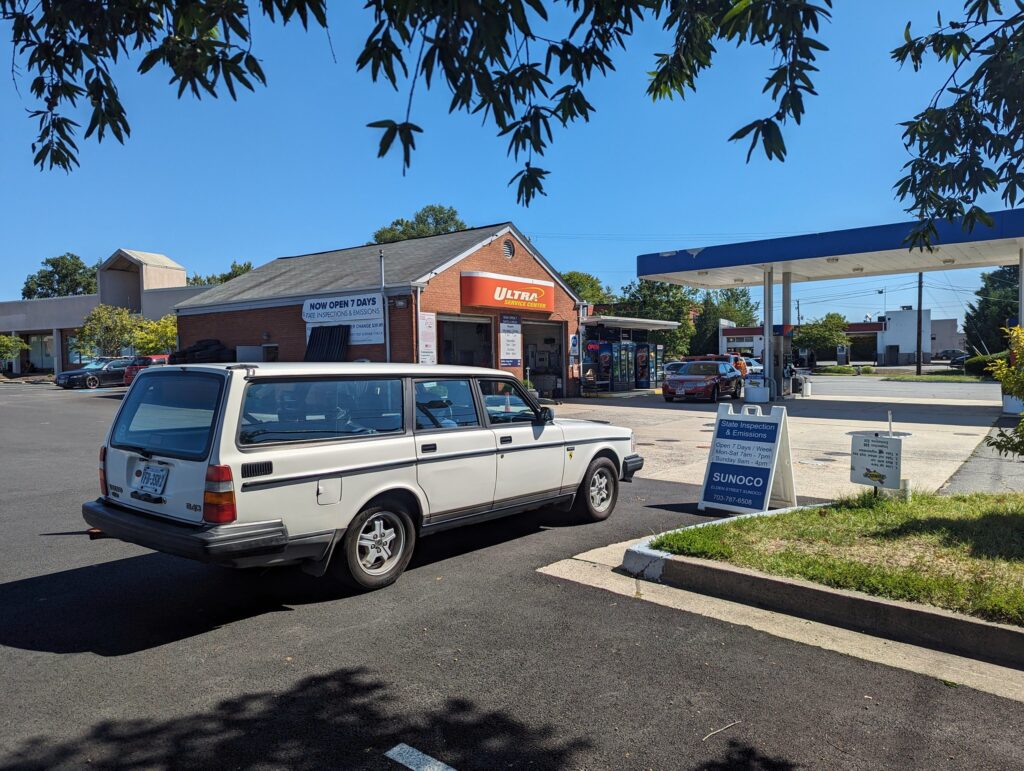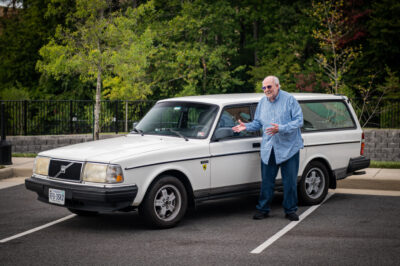This isn’t a typical BimmerLife story as the main vehicular subject isn’t a BMW, but fear not, there are still BMWs, BMW CCA members, and the wonderful spirit of Club camaraderie in the mix. And if you have any love for RADwood-era proper-roof-length vehicles, this transformatory tale of Swedish touring will be right up your alley.
One of my earliest automotive memories is riding in the rear-facing seat of my parents’ Volvo 240 wagon in the 1980s. It left an impression on me, and apparently one on my dad, Terry Bevels, too. In 2010, he was presented with an opportunity to purchase a white 1993 Volvo 240 wagon from a friend moving overseas, and he jumped at the chance. It was a mint example, with only 129,000 miles on the odometer, which is almost nothing for a 240’s 2.3-liter four-cylinder 114-horsepower B230 engine. It’s not a quick car by any means, but despite having owned a number of fast Porsches and S-flavored Audis, the Volvo 240 is the only car he’s received a speeding ticket in.
After a few years of nostalgic driving, my dad planned to move onto something newer and more comfortable. He asked if I wanted to take ownership of the 240—yes, please!—and then signed the title over to me. I used it as a daily driver for a couple of years, which was more comfortable than my track-prepped Subaru STI.
About a year after my daughter was born, I was looking to make some automotive changes myself. I sold my STI, bought my first BMW—a 2015 328i Sports Wagon—and gave the Volvo 240 wagon back to my dad. Since then, he has used it as his daily driver, but as of late, the Volvo has sat in a garage. Its tires had lost air, a layer of dust had accumulated on the exterior, and it wouldn’t start. My dad wanted to sell it and move on.
With three of my own BMW projects at home, I didn’t have space to take ownership again. So, we devised a plan to get it running and find a new owner who would appreciate it.
Round One: Diagnostics
I planned a mid-week excursion to visit my dad and take a look at the 240. The first order of business was to figure out why the 240 wasn’t running. A multimeter showed the battery didn’t have enough juice. A jump showed that the alternator wasn’t providing enough—or any?—voltage to maintain the battery.
A few years ago, when my 1991 BMW 318iS wouldn’t start at a CCA event, I learned from National Capital Chapter Vice President James Laws that the voltage regulator (VR) could be the culprit. A bad or worn VR can cause both undercharging and overcharging issues. In the case of my 318iS, the VR’s two brushes that ride on the alternator’s shaft were completely worn down, so the battery wasn’t being charged at all. A quick and inexpensive VR replacement resurrected the E30’s charging system.
The Volvo 240 has a very similar alternator to my 318iS (and I’m sure many other cars as well), so the VR is simply held on with two screws. Unfortunately, in the 240’s case, there’s not much room for access. And since the alternator would need to be removed to inspect or replace the VR anyway, I decided it would be easiest (and the most time efficient) to replace the whole unit.
Round Two: Get It Running
I returned the following week with a new alternator in hand. As the 240 was parked in a shared underground garage with vehicles parked on both sides, there wasn’t any access to jump it this time. Instead, I removed the battery and let it charge off my running 1998 M3 sedan, which was serving as my mobile mechanic vehicle for the day.
- Mobile mechanic M3.
- All the tools (and then some) needed for a remote alternator replacement.
While the 240’s battery charged, I got to work removing the old alternator. There were a few stuck nuts and bolts, which my cordless impact handled with ease. I found it easier to work underneath the car than from the top, so half way through the job I removed the splash guard and jacked up the passenger side of the 240. My cardboard creeper—thanks IKEA!—was marginally better than laying directly on the concrete floor.
After three hours, and a couple conversations with parking-spot neighbors about BMWs, Volvos, and their own 80s and 90s wagon-ownership experiences, the new alternator was installed and the car was running. However, the battery was only receiving 13.0 volts—higher than it was prior to the alternator replacement, but not in the 13.8–14.2-volt range it should have been. Something still wasn’t quite right, so another round of fixes were in order.

Mr. Laws was right again! The brushes typically extend a full inch and there’s not much left of these.
Round Three: Say When
A few days later, I revisited my old long-roof friend for round three—replacing the crank pulley. The pulley comprises two metal pieces, separated with a rubber isolator. The rubber had failed, causing an excessive wobble and slippage between the inner and outer portions of the pulley. I’ve read about this happening on E30-generation 3 Series vehicles, which can cause havoc with timing readings, so it’s not just limited to 240s.
My 3 Series wagon served as this trip’s mobile mechanic vehicle. I brought nearly all my tools save for a few things that I knew I wouldn’t need, namely my Torx sockets and Torx screwdrivers. I distinctly remember thinking, “Now there’s one thing I don’t need to bring.” As you can probably guess, I did need a variety of Torx, but made do with a small screwdriver and some vice grips.
A DeWalt half-inch impact made quick work of the crank bolt—a little too quick if you ask me. I didn’t even need to use the special Volvo B230-specific crank pulley holding tool that I had purchased. When I went to install the new crank pulley, I didn’t see the notch (or key) that it was supposed to slide into. After three hours in nearly 100-degree weather, I called it a day.
- Taking things apart for the crank pulley replacement.
- New and old crank pulleys.
Later, some research on the old-school Volvo forums informed me that the protruding key on the crankshaft timing gear was on the opposite side of where I was looking, so it was almost perfectly hidden from my field of view. Similar to Indiana Jones’ realization in Raiders of the Lost Ark, I had been digging in the wrong place.
I returned the following week, again in my F31, with the intention of finishing the job and then swapping vehicles so I could take the 240 home for a deep clean and get it listed for sale. Two hours went by in a flash and seemingly everything fell into place perfectly. I even used the special-purchase crank-holding tool to torque the crank pulley bolt to 44 foot-pounds, and then turn an additional 60 degrees. The additional 60 degrees was a killer, even with a breaker bar and makeshift jack-handle extender!
It fired up on the first try and ran the smoothest I had ever seen it run. When I owned this 240 nine years ago, I spent a long time trying to diagnose a shaky engine at idle, which I now realized was likely caused by an onset failing crank pulley. As cobwebs were being blown out of the exhaust, the couple I had spoken with each of my previous visits pulled into the adjacent parking space.
“It’s alive!” I joked. They were excited as well, and happy to get some closure on the multi-week Volvo 240 project. They shared stories of their 1980s Volvo experiences before leaving me to clean up a plethora of tools laying around the car, but not before I measured 14.0 volts at the alternator with the engine running. The pulley replacement had fixed the low charging voltage as the outer portion of the pulley was no longer slipping. Score!
Round Four: A Deep Clean
With the 240 running and driving, it was time to take it home for a deep clean. A full interior and exterior detail were in order as the wagon looked like a barn find with the layer of dust and dirt that had settled on its original refrigerator white paint.
- Cobwebs inside…
- … and out.
I swapped one white four-cylinder wagon for another—a 328i for a 240. The drive home in the 240 was an experience. The engine was strong, the four-speed automatic shifted confidently, the cooling system worked beautifully, and the suspension made for a comfortable ride. Memories of my time with this car a decade ago came flooding back.
There was a good car under the layers of dust and dirt. A couple hours cleaning the interior, an hour in the engine bay, and an hour (and many, many rags) washing the exterior yielded surprisingly good results. Of course, it would look even better with a proper polish and wax.
- Before cleaning.
- After cleaning.
So, the following day I pulled the 240 into the garage alongside my E30 for further detailing. After taping off the trim, I clayed, polished, and waxed the paint. My Harbor Freight orbital handled the polishing and waxing tasks, and a few hours later the results were astounding. As a karmic reward for cleaning, I did find and replace a number of cracked and broken vacuum hoses under the hood, making the engine run even more smoothly.
- A few items for detailing.
- I’ve always wanted to use the tape trick to see the before and after.
- Taping off the trim.
- It’s all in the details.
That evening, I took my daughter to her soccer practice in the gleaming 240. Now nine years old, she didn’t remember the last time she rode in this 240 was under my ownership when she was one. While she’s no stranger to older vehicles, with my ‘91 318iS being her favorite car, she said she was a bit embarrassed to take the Volvo as we planned to give one of her friends a ride home. To both my daughter’s and my surprise, when we walked to the 240 after practice, her friend exclaimed, “What is THIS?!? This is so cool!” That couldn’t have gone better.
Round Five: The State Safety Inspection
I stopped by my local Sunoco’s inspection station and pulled the 240 right into the garage. The inspector spent 30 minutes checking the Volvo’s systems, with a handful of other mechanics looking over the vehicle with surprise and approval. It passed. I knew it would, but that didn’t mean I wasn’t a bit anxious waiting to find out. Yes, it’s old enough to wear antique tags in Virginia, which would no longer require a yearly safety inspection, but for twenty bucks a fresh inspection sticker would be another selling point.
Round Six: Katie’s Cars and Coffee
With the 240 being its best self, I took it out for a long drive with a familiar Cars and Coffee event being the destination—Katie’s Cars and Coffee in Great Falls, Virginia.
It was a fun-filled morning catching up with good friends. Friends like National Capital Chapter (NCC) member Jackson Allen, who brought a—gasp!—Porsche 911 to the weekly event. I met Allen in 2019, when he was my instructor at a BMW CCA HPDE event, and we’ve kept in touch. As we walked the Cars and Coffee parking lot like kids in a candy store, he shared stories of his own Volvo 240 ownership experiences. An ’86 Volvo 240 wagon was his first car, so this one brought back a lot of fond memories. Come to find out, Allen shares some automotive ownership history with both my dad (a Porsche 911, Porsche Boxster, and Volvo 240) and me (a five-speed-manual E36 M3 sedan and Volvo 240).
Every time I drive the 240, it’s a conversation starter—more so than anything else I’ve ever driven. And I think that’s because so many people either had one or knew someone who had one back in the car’s hay day. It was such an attainable car for the masses for the better part of two decades, 1975 to 1993. Every time I’m out, someone will either stop me in a parking lot, motion for me to roll down a window, or walk down my driveway so they can share their 240 stories.
- Dad is happy with the outcome.
- A drive down memory lane.
Owning classic cars (or cars from your childhood) is a multi-layered experience. For me, it’s about adventure. It’s about constant improvement and making something better than when it came to me. It’s about challenging myself, having an objective, and tangible evidence that I’ve done something well. It’s about connecting with strangers, and stirring nostalgia in myself and others. And when it’s time to find cars like these a new home, you can only hope they continue to bring the same joy and experiences to their new owners.
- NCC member Jackson Allen is happy with his new wagon.
- Farewell old friend.
And on that note, Jackson Allen, the friend (and BMW CCA member) that I met at Katie’s Cars and Coffee, bought my dad’s 240. Since Allen took it home, he has texted me daily status updates of what he’s doing with his new purchase. I was apprehensive about selling the 240, but I couldn’t think of a better caretaker than Allen for this long-roof memory maker. —Mike Bevels





